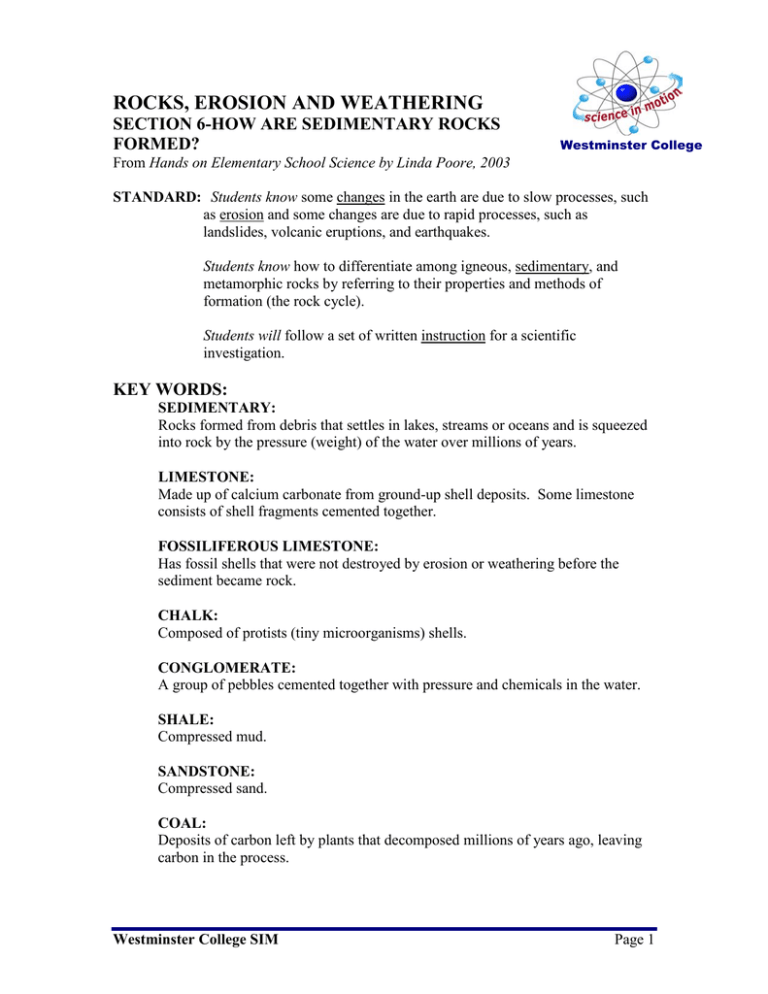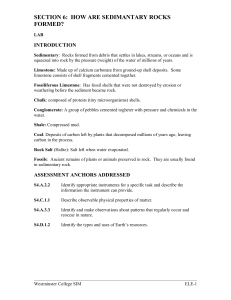ROCKS, EROSION AND WEATHERING SECTION 6-HOW ARE SEDIMENTARY ROCKS FORMED?
advertisement

ROCKS, EROSION AND WEATHERING SECTION 6-HOW ARE SEDIMENTARY ROCKS FORMED? Westminster College From Hands on Elementary School Science by Linda Poore, 2003 STANDARD: Students know some changes in the earth are due to slow processes, such as erosion and some changes are due to rapid processes, such as landslides, volcanic eruptions, and earthquakes. Students know how to differentiate among igneous, sedimentary, and metamorphic rocks by referring to their properties and methods of formation (the rock cycle). Students will follow a set of written instruction for a scientific investigation. KEY WORDS: SEDIMENTARY: Rocks formed from debris that settles in lakes, streams or oceans and is squeezed into rock by the pressure (weight) of the water over millions of years. LIMESTONE: Made up of calcium carbonate from ground-up shell deposits. Some limestone consists of shell fragments cemented together. FOSSILIFEROUS LIMESTONE: Has fossil shells that were not destroyed by erosion or weathering before the sediment became rock. CHALK: Composed of protists (tiny microorganisms) shells. CONGLOMERATE: A group of pebbles cemented together with pressure and chemicals in the water. SHALE: Compressed mud. SANDSTONE: Compressed sand. COAL: Deposits of carbon left by plants that decomposed millions of years ago, leaving carbon in the process. Westminster College SIM Page 1 How are Sedimentary Rocks Formed ROCK SALT (HALITE): Salt left when water evaporated. FOSSILS: Ancient remains of plants or animals preserved in rock. They are usually found in sedimentary rock. MATERIALS: For the Teacher: 1 tall jar clay soil (red) sand soil 1 Sedimentator™ DEMONSTRATE: OBSERVING SEDIMENTS 1. Discuss why streams are full of rocks, sand, dirt, etc. (Streams flowing over rock gradually wear the rock away. This is erosion. The sediments are then carried away by water and wind.) [S, sedimentary-properties/formation] 2. Show students the clay, sand, and dirt and ask them which would sink to the bottom of the river first. (sand-heavy objects) Pour 1” of each material into the jar and observe the layers. Have the students record which layer was put in first. 3. RIVER DEPOSIT SEDIMENT What would happen if each year more materials were carried by the river to the ocean. (Layers build up over time.) Encourage students to bring in samples of sand and soil. Put several more layers of soil of different colors into the jar (clay, sand, etc.)one layer at a time. Which layer was laid down first and is the oldest? (Layer on the bottom, unless the jar was shaken.) Use this jar for layering sediments by other classes. Keep a chart of the date each layer was added. Draw and label. Westminster College SIM Page 2 How are Sedimentary Rocks Formed 4. OBSERVING RIVER FLOW – THE SEDIMENTATOR™ Group the students close to the table. Hold the Sedimentator™ horizontally and slightly tilt the ends up and down so the water moves back and forth. Which material moves the most? (soil) Which material stays on the bottom? (rocks, sand) What will happen to the sand and gravel as it tumbles along the bottom? (Rocks are broken up. The edges are rounded.) Time how long it takes the plant and soil material to settle. [S, changes-erosion] 5. WHICH MATERIAL IS DEPOSITED FIRST? As the river enters the ocean or a lake and slows down, the heavier materials (rocks) are deposited first and the light materials (silt, clay) are carried further before being deposited. Thus, similar materials are deposited together in a layer. [S, sedimentary-properties/formation] 6. SEDIMENTS BECOME ROCKS The pressure of the water (ocean or lake) on sediments over thousands of years cements the materials together, making them hard. Rocks made in layers are called sedimentary rock, meaning made from sediments. [S, sedimentary-formation] ASSESSMENT: 1. Predict what will happen when the teacher turns the Sedimentator™ upside down. Explain your prediction. Demonstrate: Hold the Sedimentator™ vertically and rapidly turn it upside down. (heavier objects are on the bottom) 2. Explain why the water is brown. (dirt is lighter and floats) 3. Which material stays suspended in the water the longest time? (soil and organic material in the soil) 4. Which layer is on the bottom? (the heaviest) [S, predict] TEACHING TIP: The Sedimentator™ must be kept in the dark so green algae cannot grow inside. When not in use, store with its instruction sheets wrapped around it to keep the light out. MATERIALS: For Each Pair: red sandstone gray sandstone limestone chalk shale conglomerate magnifier Westminster College SIM For the Teacher: 1 cup water 18 fossiliferous limestone rocks Page 3 How are Sedimentary Rocks Formed EXPLORE: OBSERVING SEDIMENTARY ROCKS [S, sedimentary-properties/formation] 1. Pass out rocks (except fossiliferous limestone) on a tray to each pair of students. Observe and compare rocks. Use magnifier. Do Not tell students the names of the rocks until later. Challenge students to discover which rock is made from mud, shells, small rocks, or sand. (Write mud, rocks, sand and shells on the board). SEDIMENTS FORM IN LAYERS 2. Can you see layers in any of the rocks? (shale) Wet the dark, flat rock (shale) and smell it. Discuss. (smells like mud) WHAT FORMED THESE ROCKS 3. Have students hold up rocks made form sand. Check students. Tell them it is called sandstone. Continue identifying rocks by having students holdup a rock made of pebbles (conglomerate), mud (shale), shells (limestone), and tiny microscopic animals (chalk-the tiny particles make it soft). SANDSTONE [S, changes-erosion] 4. Have students rub sandstone with shale, gently over paper. This is how sandpaper is made!!! (Stop after 10 seconds) CONGLOMERATE ROCKS 5. How do conglomerates differ from the other rocks? (many different rocks together) Which is older, the pebbles or the conglomerate itself? (pebbles) How do the pebbles differ in the conglomerate rock? (Color, size, shape, different rock types) What holds the pebbles together? (Cemented together with pressure from water and chemicals, such as silica and calcium carbonate.) [S, sedimentary-formation] LIMESTONE 6. Pass out the fossiliferous limestone. Observe with a magnifier. Compare to the other limestone. Why is it different? (The shells were not destroyed by erosion and weathering in fossiliferous limestone. Usually the tiny shells are crushed by waves into a fine powder.) Remind students that most fossils are found in sedimentary rock. (Sediments covered the organism and after the organism decayed, an imprint and space was left that matched the organism.) Draw some of the shell fossils in the limestone. Trade rocks to observe more fossils. [S, write-draw] Westminster College SIM Page 4







